"An open letter to Pedro"
Dear Pedro,
You asked me for a note for your website. I am in Paris and I’m no art critic, but I am your friend; so an open letter would seem the simplest and most genuine way to introduce your work to the Portuguese public.
Pedro, I want here to convey to you the surprise, the gratitude and the admiration aroused in me when I discovered your work. As far as I have seen during a year spent in Portugal and ten in Paris, painting is – with certain rare exceptions – extremely boring. Painters have become the most respectable and clever of people. A new pomposity has descended on the world of painting, even – especially – if this new academicism claims to be “avant garde”. The twin blights of intellectualism and ornamentalism ravage all, and Portugal has not been immune from this intellectual and aesthetic domestication of art. When I discovered – all in a single sitting! – your paintings, great was my joy: “At last, someone who paints from instinct!” I thought. “At last someone who paints freely, with feeling!” I also thought. And I further though: “At last – a plural painter.” I do not have the space here to say all that fills my heart: the innocence of your painting; its warmth; its humour; its richness; its depth; its mystery... so I will go straight to the essence of that joy – which is multiplicity. As a painter, I have the strong impression that in you I have met a brother in painting. Painters, roughly speaking, may be divided into two categories: those who find their path and then relentlessly pursue it at great depth (best case) or tirelessly run it into the ground (worst case); and those who explore all paths, clearing the way as they go. You, obviously, belong to the second group. You have a hundred paintings: a hundred subjects, a hundred styles, a hundred forms. I believe variety for you is a kind of religion: and not as a meaningless exercise, but a vital necessity, a condition for your very being, and one which has many eyes, many ways of seeing, many hearts, many brains, which is composed of many selves, which is many. You give breathing space to all the beings that live in you, and each painting extends its hospitality to one of your “others”, each canvas expresses a facet of your sparkling personality, each picture is an adventure into the still virgin confines of yourself, towards an “interior India” of your soul (in this respect your painting seems to me to be eminently Portuguese), and all these voyages bordering on clairvoyance, all these “trips”, are at once technical (you experiment with everything), formal (you excavate the full range of artistic languages) and spiritual. For me, the spirits are with you. And I see in this frantic quest for forms and metamorphoses no flight from an undiscovered self: I see, on the contrary, an attempt to sing life out loud, life in its entirety – a desire to convert life to visions. Yet life is polyphony, and your paintings give voice to this polyphony of life, this choir of all voices, in all its consonance and assonance. Your varied and intense art is the living illustration of one of Paul Klee’s most beautiful precept: “to be as mobile as great nature itself.” It occurs to me that after Rimbaud and his ““I” is an other”, the one who took this multiplication of personality to the furthest limit was a Portuguese, one who went by the name of Fernando Pessoa.
“I multiplied in order to experience myself.
To experience myself, I had to experience everything.”
“Each of us is many within one, is numerous, is a proliferation of selves”, he wrote. Of the fact that you are, in painting terms, one of the spiritual offspring of this protean artist there can for me be no doubt whatsoever. But the human being, desperate for his own unity, finds it difficult to tolerate or understand those who attempt to live out in their art this multiplicity, this profusion of nature and thus of human nature. I have the impression that your work will garner a cold of negative reception from the art critics, insofar as free spirits generally come up against hostility; but I say “Nuts!” to the critics. The beauty (let us not be afraid to use that word) of your canvases will gain both acceptance and enthusiasm, I am certain of it; and when beauty is married to the diversity of all that is alive, art can manage perfectly well without speeches: so I will limit mine to an invitation to see what you have; I hope with all my heart that those who come to see your pictures will display the same freedom, the same courage in seeing them as you have shown in allowing them to be seen. Whatever your reception, my very own Portuguese brother in painting, I wish you no more than to continue to paint, desperately, no more, in fact, than to continue this, you painter’s fado.
Simon
Pedro le fou
“I multiplied in order to experience myself.
To experience myself, I had to experience everything.”
Fernando Pessoa, Passage of the Hours
Encounter with Other
The simple act of meeting another person who is truly Other is a real joy. We spend our lives meeting people just like us, which is reassuring but leads nowhere. It is difference that enables us to progress. Happy are those who evercome their initial fear – true otherness is frightening – and confront that Other, getting to know him and thus themselves in the process.
Yesterday, when I met Pedro Garcia Fernandes, alias Pedro o louco (Portuguese for Pierrot le fou), my joy was unconfined, for here was a man who was Other in an an artistic as much as a human sense.
At last, a Mad, I thought.
(Professional artists in Portugal are sensible people.)
My brain sang and danced and I inwardly rejoiced.
Oporto is not a city that immediately delivers up the secrets concealed in the sediments of its streets and houses; so it was some months before I even managed to make contact. I had heard tell of him, and even sold his father and brother some drawings. An encounter had been arranged by an intermediary. He had not shown up. I had not insisted. However, I looked for him, tracked him down, without realizing it.
An amateur painter?
Pedro GF, Portuguese, age 39, merchant (import/export), consul’s son and consul’s brother, paints. Never exhibited, never sold, never wanted to.
Yet he is a Painter, I swear.
He first painted at age 29, followed a course for one year at the Arvore Cooperative; has been painting doggedly since; sought neither fame nor gain. In a word, an amateur painter.
But beware: it could be that one amateur painter (is that not what Gauguin was for some time?) is worth much more than many amateur painters – and no less than many professionals, indeed a good deal more.
His nearest and dearest hold him in low artistic esteem; an amateur slightly off his head who “dabbles in lines and blobs” and, occasionally, “nice things”...
What do I care, as long as I am convinced I am dealing with a painter, a kindred if somewhat unfamiliar painter of the most necessary sort: not only a painter who does “nice things” but also a free artist, and not only a free artist but an artist of that rare breed who produce liberated beauty (in this case to the point of appearing completely mad), and thus an artist who liberates. Like Picasso, Dali, Dubuffet. In any case, meeting Pedro le fou set free in me a flow of energies, of questions, of impulses.
Pedro: Full-length portrait
I spotted him from afar: a bit strange. Off-the-bat strange, and not hiding his strangeness. He came closer. Yes, skinny like an Oporto cat – in a word, not very “Portuguese” (usually meaning thickset and stocky)! Thin in the way a sable hairbrush is thin, rather than biro-style: a supple, lively, nervous thin, the thin of someone who feels strongly about things. “When I was born, they thought I’d had it: I had rickets – ‘His bulb’s gone’, they said. I survived.”
Moustache.
A pencil job, like Dali, or Monsieur Verdoux.
A walking-stick in his hand. That hand, too: bony, vibrant; long fingers going a long way up, and with a long way to go. I shake his hand, we are introduced. What a hand!
These references to the painting of the past, to the cinema of the past, that stick, reveal the anachronism of this character, and his cosmopolitan aspect. He has English chic crossed with Spanish panache. Yet the man is almost exaggeratedly Portuguese: friendly from the outset, simple, not at all formal. The cliché would have it that thin people are as cold as fork handles. This thin person is as warm as a fiddler’s bow. Within minutes, we are talking away like old friends. Two beer please! He tell me about a car accident, his mangled face, the tongue poking out from a hole between the eyes, expensive plastic surgery; how he wanted to be a pilot in the Angolan war, and his father’s desperate efforts to dissuade him, pleading in vain with the military authorities: “I was just about to go when, suddenly, I fell gravely ill” – but never mind the life story!
I am here to speak of painting.
Pedro has never made one sale: his paintings are all in his house.
Pedro’s house
Let’s go into the house.
It is the tallest building in the Muro dos Bacalhoeiros, on Ribeira dock, Oporto. From the outside, you count four floors. Inside there are eight. A plaque on the door reads “Consulate of Colombia”. Now we’re in. Cellar: an art gallery that has never been opened (Pedro is scared). Ground, first and second floors: consulate offices. A spiral staircase in delicate brass, eccentric in this granite house, leads upwards.
Fourth floor: Pedro’s room.
Fifth floor: living room and kitchen.
Sixth floor: attic studio with balcony over the Douro.
From top to bottom, paintings hanging from the stone walls. This house!
To art galleries as white as aspirins, lined with pictures more often than not depressing, offering the visitor the most glacial of receptions, how can one resist contrasting Pedro le fou’s house, where the warmth from the pictures is tangible, the reception a glass of beer and everything else goes with it?
Here is a dwelling where pictures and things live on good terms in joyous equality: it seems that the latter are not looked down on by the former, whose populace in turn do not rise up against the other’s privileges.
Collections of walking sticks make common cause with tubes of paint and do not burst them. Rifles lean up against walls with the paintings and do not shoot them down.
Custom requires that a place pay more honour either to the object d’art – as do antique shops and the majority of houses – or to the work of art – as do museums, galleries and some houses. When the curio takes precedence, valuable artworks (if any), lost amid the muddle, are relegated to the ranks of wallpaper.
In short, the accompaniment of objects d’art and works of art is an art in itself. The house-cum-museum of Pedro le fou makes mock of such rivalry, and the conviviality of pictures and objects here bears witness to that of its occupant with them, and with others.
I notice that the residence of Pedro le fou is the humbler cousin of the Dali museum house in Figueiras – its nicer cousin, moreover: just as I reject Dali’s dump in all its bombast, for it was visited above all by megalomania, so visiting Pedro’s house seemed warm and friendly, like a nursery school where the painted wooden toys rub shoulders with fabulous doodlings.
But despite this happy equity between objects and paintings, it is of the latter that I wish to offer an account. (Sorry, then, door handles, coffee pots and suits of armour; you will have to excuse me – of you I have nothing to say.)
Paintings: The genius of disjunction
I was not expecting anything decent: layers of paint as I have seen so many times before. The first painting seemed to confirm my apprehension: it was a larva of a work. The second, at a half metre’s distance, a caterpillar: some evolution already evident, then, to a creature endowed with colours and feet, segmented and consequently equipped to go further afield. The third was superb: a butterfly with a splendid array of colour had taken flight. Will I speak in even more glowing terms of the fourth picture? No – rather than an evolution from a beautiful butterfly to some superior one, there is a leap from butterfly to precious stone, from precious stone to humble pebble, from pebble to cloud, and endless astounding metamorphoses: to pass from one painting to the next is to visit a collection of flights of fancy: from exotic butterfly to clump of earth, from there to astonishing shellfish, and on to stuffed animal, from caravel to cockleboat, and from bric to brac. Allow me merely to use this metaphor to sketch out a critical study: Pedro’s method (if method there be) consists of continuous moulting. It is, let us be clear, his brain which moults. Transformations such as there, quite common in fairyland, are less so in the world of art: he who paints boats persists in painting boats; it is rare for him to attempt airplanes. This is why one is so taken aback by the range of subjects, styles and forms in Pedro’s art. If humanity’s genius, as opposed to that of the animal kingdom, resides in the infinity of these mental metamorphoses, then Pedro is certainly no mental deficient. I am reminded of that poem by Michaux (“Still more changes”, from My properties) where the narrator assumes every form possible and imaginable, in an agonized cacophony. Pedro’s brain has given life to just such a protean world. I note here, therefore, a true genius of disjunction. The notion of transition, from which creation generally proceeds (like the passage from one era to the next, degree by degree), is here not current.
In short: it is not impossible that this guy is touched with genius.
It is also highly possible that I am mistaken, and that Pedro is a Proteus as ephemeral as he is luxuriant, whose shimmering scales glow in so many ways that I was dazzled. Something in the course of this contemplative promenade, however, defies reason. Anyone who did not know that all these paintings are the work of one man would swear that at least ten artists were on show here. And that visitor would exclaim, “This is a group exhibit?”
“No, they’re all my own work.”
“You’re not trying to tell me you did all that on your own?”
One would in a sense be forced to conclude that this is a group exhibit – by one man. And if Pedro’s creation defies plain reason, which asserts unity of personality, it also defies “artistic reason”, which demands unity of style. The rule laid down decrees that any artist worthy of the name finds his style and stamps his trademark on all his works, however many and various. Why do the critics (and the rest of us, if the truth be told) lick their lips so at the moment of pronouncing that so and so “has found his style”? Is there not in this satisfaction an element of relief? The artist has traded plural for singular: we can at last pin hum down. We say, “It’s a Picasso”; we are reassured that the profusion of Picassos may be narrowed down to just the one. Yet Picasso is anything but one and indivisible. But when all is said and done, is this quite commendable rule that says the artist must invent his language and inviolable one? Is it still justifiable today, in this new medieval era, where images anonymously proliferate? In the Middle Ages, did anyone feel the need to stand before a statue of the Virgin and say, “It’s a...”? The question did not arise: only the Virgin counted. Aren’t the modern malady of the name and the cult of artistic idols (cf. The Van Gogh phenomenon) distorting the living relationship between spectator and work, which alone matters?
Let us return to Pedro’s house.
Thirty pictures.
Thirty subjects.
Thirty styles.
Cornucopia.
“To be only one is a jail.”
“To be me alone is to not be.”
Fernando Pessoa
Pedro’s paintings
There is a picture “painted with a roller”: bands of bright colours, reminiscent of photos in biology textbooks or maybe coloured scarves in an abstract video. I ask him the title. It’s called Vida (“Life”). As if by chance.
Freedom of subject.
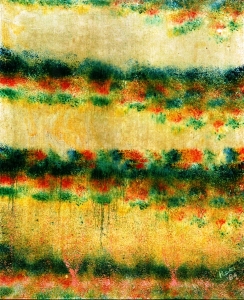
There is a picture of pink vertical strokes, planted on a green surface. Apartment blocks? Ears of corn? Simple strips of colour? Maybe. Above these strokes, a profusion of bright blotches, maybe. A whole tendency in modern thought is there: not such and such a thing, but “maybe-things” – maybe Manhattan, maybe a cornfield, or all of the above; a firework, for example. (The picture is called “Pollution.)
Freedom of vision.
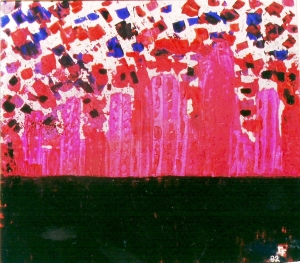
There is a Christ on the cross, a picture stippled with a jumble of golden points. A new and valid icon: for here, the entire painting is studded.
Freedom of interpretation.
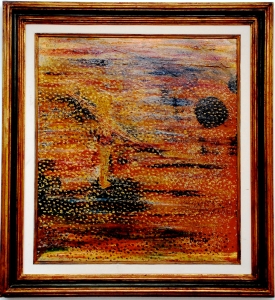
There is a picture called Urso (“Bear”), with a bear in the foreground. A friendly teddy, of paint instead of fur. An adult teddy. To hang above the bed.
Freedom of naivety.
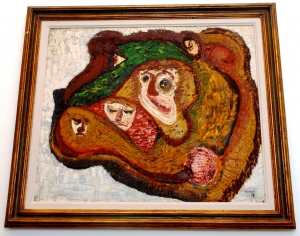
There is a picture consisting of white, grey and portwine-coloured vertical tracks which suggests a view of the Ribeira. “What’s that one called, Pedro?”
O inferno de Pedro (Pedro’s Inferno”.)
Done with knife.
Freedom of title.
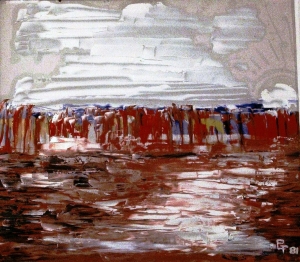
There is an Indian Chief in monochrome (Vandyke brown), like a clay mask applied to the canvas. (The canvases, I should explain, consist of aluminium offset plates.)
Freedom of theme.
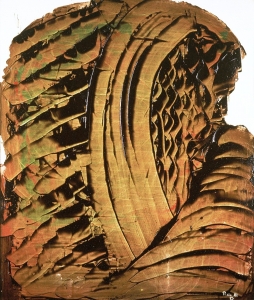
There is a white explosion in a thick, dark brown night, a vaguely triangular shape. This one is so dramatic that one would like to call it “Cataclysm”, or “Nightmare”, or “Night of Hideous White”, or “Leukemia”. Clichés! “What’s the picture called, Pedro?”
Barco a vela (“Sailboat”).
Why didn’t I sink... er, think of that before?
Freedom to imagine.
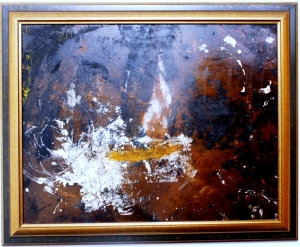
There is a car, or rather an old banger. A sort of Volkswagen trying to be a truck. She’s funny, comic. She huffs, she puffs, she moans, she groans... and her wheels spin hopelessly in the mud. “For me”, says Pedro, “this one’s called ‘Buggy’. But if people want to call it Monstro, I don’t mind.”
Freedom of the spectator.
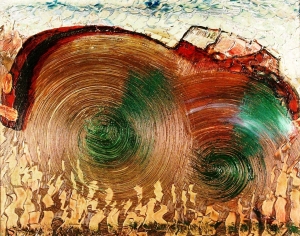
There is a man with limbs crazily splayed out, marsupial style. But look closer: how many limbs does he have? Five? That’s odd. How come? Look closer still: that’s it! It’s his third leg, up in the air like the others! And just as big and long as the others, indeed. What a chopper! It’s a man in rut, that’s all. And it’s nice. That’s right: all his members are erect. Clever! “I call it Audacia. I don’t know whether you see that it is rather daring for a man in my position, son and brother of consuls, that kind of family background, to do a self-portrait with erection?”
How charmingly naive! Does he know Egon Schiele? But remember: we are in the Portugal of 1990, which is not the same as the “Europe” of 1990: there are 43 years of Salazar behind it, a church which is still influential, and the depiction of the male nude is prohibited. Such a painting therefore constitutes a minor blasphemy. Yet despite its subject, there is nothing salacious or provocative about the picture. It is naturally erotic, in the way dangling genitals are not. It is documentary of biology, in farcical guise.
Freedom to be ironical.
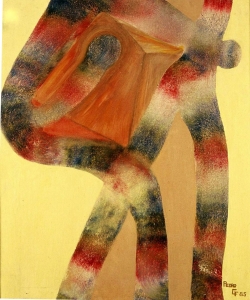
There is a small picture of two trees.
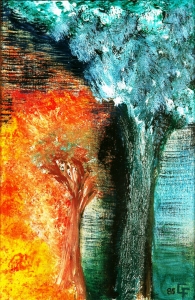
One is bursting with green, the other with red. “My brother sees two trees badly drawn; that’s his right. They are only a couple of trees, after all. He’s probably right. “Such modesty, Pedro! I see a tree on fire, a tree amid drama (the artist grappling with his passion?) and a tree rejoicing in its spring chlorophyll. Side by side. Where the academic painter would have produced a sumptuous “Forest Fire” so real it has you reaching for the extinguisher, and a no less sumptuous “Spring Forest” on a separate canvas, Pedro’s genius was to bring together two opposing subjects on the same one. Imagine two orchestras simultaneously playing Vivaldi’s “Spring” and “Summer”. A primitive painter, yes. A painter who cannot draw, yes. (I am reminded of Baudelaire on the Painter of Modern Life: “He drew like a barbarian, like a child...”) Thus a painter who feels primitive forces, those of the tree exultant with sap and the tree in agony, and so a painter with strong feelings like a child. A Heraclitean painter.
(A parenthesis: Pedro does suffer from this complex – “I cannot draw; I have no gift for drawing.” After studying his painting at length, I told him: “You are a painter; and maybe you are also fundamentally a painter because you are not good at drawing. It is by no means certain that your painting would have the same force if you were.” I even believe that the atrophy of one gift – drawing, in this case – caused the flowering of the other.)
There is a charmingly playful little picture: flimsy boats in gold leaf (the sort used to wrap fine chocolates) have been stuck on a navy blue background of sky and sea. As for the stars in the heavens, they are symbolized by fake diamonds, no less, set in oily paste. “This is called Ouro sobre azul”
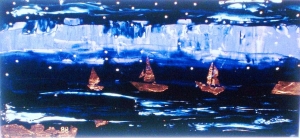
(“Gold on Blue”, which in Portuguese means “the last word”). “Someone offered to buy it; I said no, I’m not interested. Sell it for 5000 escudos, or 50,000? No, I’d rather keep it. I don’t need 50,000 escudos. If this picture is valuable, as the title says, it may as well be really valuable. What would interest me would be to find a jeweller willing to sell me... let’s say ten real diamonds. I inlay them instead of the fakes and then it acquires value. It’s worth a million. Or ten million. Then it’s worth selling. The buyer wants something of value? Let him pay for it. He pays a million. Or ten. Ouro sobre azul, then I agree.”
This shocked me at first. Then I examined my own bias. A picture by Van Gogh sells for X million dollars. A totally unreal price that has nothing to do with the painting. The price is quite external to the picture, an outrageous inflation of the listed value. It is the same price as you would pay for an entire jeweller’s. Pedro, who wants to put the value into the picture, the dollars into the very body of the painting, and not into an abstract name and a sanctified art, is practising a surrealist approach which is much less far-fetched than it seems. Did Picasso not put cars and César emblems of industry in their sculpture? Did the Baroque craftsmen at the time of the Enlightenment not stuff the churches with gold and precious wood? Why not put the dough (in the form of diamonds) – the market value – into the work of art?
Freedom to absorb.
There is a picture made by a couple’s bare, dancing feet, treading in the paint. Instead of the tiresome mess one might have expected, the painting comprises a splash that recalls two bodies dancing through foliage. By what tortuous route such squelching about manage to produce such a painting is no less mysterious than this: from the vat where grape pickers tread a slimy pulp – will come wine.
Freedom of manufacture.
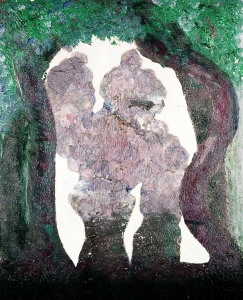
There is a painting made with oil and sawdust,
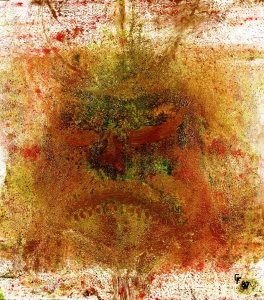
and onto which have been transplanted various organs (brush, tube, scarf);
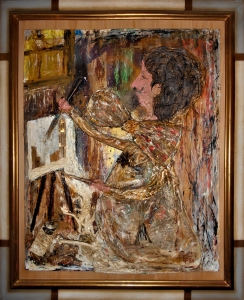
a painting in oil, sand and mosquito blood
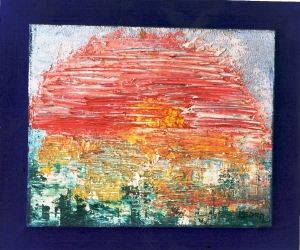
(“You have to use what’s to hand: it was hot, the mosquitoes were biting me all over; I squashed them in the oil, with my blood.”); a painting smeared with shit, as well as other experiments.
Freedom of technique.
There is a painting of the most hackneyed of subjects: a bowl of flowers. Yet the impression gained from this bowl of flowers is unique. Strong. It is a long time since I saw such an expressive bowl of flowers. How or why, I would be unable to explain without going into it at greater length. It seems to me, briefly, that in this case Pedro opened himself, to the spirit of that bowl of flowers, that he felt that bouquet in his chest, the scarlet ventricles of the peonies and the sensuous mane of the fern: in a word, that he made himself into a flower during the painting of the picture. Strangely enough, in ancient times, the fruit of the lotus flower was considered to have magical powers, causing Ulysses’ companions to forget their homeland. Did Pedro too forget his homeland – his own being, his humanity – to become vegetal? I do not know. But how far he went in green, this budding painter! Under the influence of what opium, peyote or hashing he became a flower I cannot say, and it is of little consequence. Perhaps he only drank a glass of water to bring his bowl of flowers to life. But he indisputably understood that so-called lifeless nature and incarnated himself in the flower dying in the bowl in order to extract its living essence and its last lights, for otherwise how to explain the dramatic character of this picture, which could have been merely a placid bowl of flowers? What does Pedro say? “I went through various fits of despair over that painting. There were five sittings, spread over months. At last, there it was.” Oh yes, making yourself into a bowl of flowers is clearly more difficult than going out and picking daisies and poppies!
Freedom of incarnation.
“Go deep into the intimacy of the subject,” said Paul Klee.
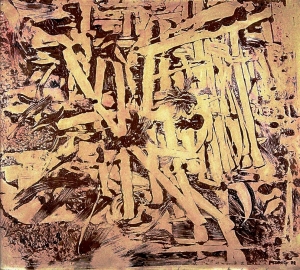
There is a strange brown calligram: signs that appear more vestigial than actual. Pedro explains: “I did a painting; it was a daub. But it radiated something else; there was a germ of life in the compost. I printed the wet canvas onto another, and destroyed the positive. This is the result. I like it a lot”.
One might ask what could possibly come from the negative of a picture returned to nothingness. Not a lot, probably. And yet... it is beautiful. And it is no less real than a fingerprint, no less important than a Stone Age handprint on a wall. A pictorial fingerprint.
Freedom to fail, and find by mistake.
There are hundred interesting pictures, and numerous fascinating ones, astounding ones. I will stop here to ask myself:
1. How can someone so unreasonable, with so little mastery of the laws of beauty, so undetermined in many ways, also be a painter?
2. How can a human brain also be plural?
I left Pedro’s house in a state of great excitement: I had met an artist of the lineage of the plural painters.
Instinct?
I quickly objected to my enthusiasm: gifted amateur painters (with a certain gift for diversity) exist in abundance. Except that, because they lack the wherewithal to submit their scattered gifts to the rigours of a style, their work suffers by its disparity. These Jacks of all trades, these dabblers in all genres, these dealers in daub in fact do no more than touch the surface of things: they surf on beauty, never getting underneath. I maintain that Pedro does get underneath, plunges in, dissects. He rallies to the cause of each picture as if it were unique, immerses himself, commits himself, in a raid on the unknown territories of his brain, a trip to the darkest unexplored depths of form. Each picture is an adventure quite separate from the others. Is it that he forgets what he has done before, before he begins? I would swear to it. I think here of Wols: “The first thing I drive out of my life is memory.” To forget in order to be forced to invent. So that each picture is art beginning anew, the quest for new origins. The quest for art’s childhood. Without knowing it, Pedro shares the concerns of some of the great men of the age, whose prophet was Baudelaire: “The child sees everything as new, and is perpetually intoxicated... Genius is merely childhood deliberately regained... a childish perception – that is, an acute perception, made magic by innocence!” Hence Picasso, Klee, Wols, Dubuffet...
This desire not to repeat himself, this deliberate diversion from the beaten track, this intuitive ingenuousness, may partly explain Pedro’s gift for diversity: his talent blooms and grows in constant renewal, and I am inclined to think that if he did try to repeat himself, duplicate himself, copy himself, exploit himself, he would lose everything. Of all his great predecessors, I see only someone like Paul Klee as his equal in terms of variety. As Marcel Marnat said: “Klee is creation before it becomes set in a desire for style.” I would swear he meant Pedro. “The desire to find his style”: that is the last of his worries! Now there is a project that would make him laugh, I bet!
A Portuguese Paul Klee, then? Though in many respects related – in the variety of his techniques, his freedom of tone, the eclecticism of his subject matter, his childishness – the similarity stops there.
No theory here. No virtuosity of stroke or science of line. No project at all. Especially not. No project to be a Painter and register your name in the history of Painting. Not even any project for such and such a painting: “I am incapable of saying: Now I’m going to do that. No, I never know what will come out next.”
So?
They say a gift is something you are born with.
I can only explain Pedro’s art with one word: instinct. With no aesthetic training, the product of no rich pictorial tradition, without any predisposition, it must be that of all the amateurs who slop colours onto canvas (and the no less numerous grimy professionals who populate the world of painting), this man has in his veins and his genes the instinct for painting. And that like all instincts, this energy is power.
Madness?
I have christened Pedro le fou – “the madman”. A few years back, the word “crazy” was all the rage. “Crazy, man!” Something “crazy” was where it was at. It was marvellous, stunning, transcendant, fabulous... crazy! You could say that Pedro’s painting is “crazy”. In both senses of the word. There is here an air of madness. And for example, various and varied “madmen” have often distinguished themselves by magnificent paintings. The undoubted magnificence of some paintings, however, is sadly isolated and not followed through. There are instances of accidental beauty out of chaos. Pedro le fou demonstrates a tremendous insistence on painting, a desire to paint that goes way beyond the pleasure of painting, displaying a talent that has little to do with chance. He is a painter. Society has him down as a merchant, but his destiny is to paint. I so declare. And this madness about painting is informed with an acute, deepseated yet very real awareness of beauty. One word keeps recurring on the tongue of this raw artist: harmony.
Production and creation
What is there to say about this dazzling ability to metamorphose? If the human brain constitutes the miracle of this third infinity, the infinitely complex, it is in the biology more than the psychology of art that we should seek to probe the mystery of such a many-faceted artist. I am not yet equipped for the task. To those who would have it that such a versatile artist is unable to steady his search and deepen his language is running from himself; that he spreads himself thin out of a desire to lose himself, roams at random out of a desire to leave himself behind, is into everything because he has not found himself, I would ask this: What if this alleged hit and run approach was in fact the discovery of virgin territory, the exploration of that infinite complexity that distinguishes the human brain? Human genius comprises an infinite number of neuronal connections, those billions of synapses that transport our nerve impulses; if we consider a work of art to be the result of a few billion such connections, is it not a form of genius to be able to radically modify that synaptic combination so as to achieve another, quite different and quite unexpected work of art? A human spirit that can give free rein to the plasticity of its neuronal connections, creating new associative tissue for each painting, for example, seems to me to be an intelligent user of its natural cerebral genius. In total innocence, like a child putting together pieces of lego and all the other bits and pieces lying around the room into a construction that has never existed before and will never exist again, that human spirit makes use of the possibilities that exist within variety. (This is, of course, merely one interpretation among others to come.)
So Pedro, our moustachioed painter with long hands, offers only unique works of art. He himself is quite naive about it: “I don’t like to repeat myself”, he says, or “I did something once, I won’t do it again.” What is the meaning of this categoric rejection of repetition? Isn’t it just an extreme version of our modern worship of the different and the new? Isn’t it blasphemous with regard to the rule laid down (unity of style)? To tell you the truth, I do not know; but something here fascinates me, touches the most secret part of the creative process. We live in an industrialized society based on mass production, which in reality is reproduction. Each year, Renault churns out X Clios, all identical, and Bernard Buffet (the name itself is a stereotype) so many “Buffets”, all more or less identical. Most of today’s artists – even the best ones – have perfectly assimilated this logic of production, and hence of reproduction. They have become small producers of their talent: once they have found the formula and the client is happy, thy set to producing. The process can last a lifetime. Profits are assured. Each product resembles the others, they repeat themselves tirelessly, and their outlets are guaranteed. Let us salute these indefatigable copyists of their own corporate image, these superannuated self-imitators, these asexual self-reproducers, these comics performing ever the same turn, with their paintings that are clones of all their other paintings. What adept parrots people can make!
This is a mass production society with nothing to show for it. We manufacture without knowing why. In the world of art, which is also (at the risk of stating the obvious) that of creation and so of invention, this aberration is all the more evident. At most exhibitions, the pictures are no more distinguishable one from another than so many dishwashers in an electrical store: the difference between a Philips and a Bosch lies only in the degree of whiteness of the goods.
In this context of small producer-artists, the experience of an artist who is anti-repetition and anti-reproduction is genuinely subversive. And even more than subversive, I see in that fact the honour of painting as an act of creation being restored.
Schizophrenia?
Psychiatrists would have a field day with a case like Pedro’s. And symptoms of schizophrenia would soon be diagnosed. What is schizophrenia? A psychosis: the patient is unable to adapt to reality, which he resists by shutting himself off, retreat into the interior self, fits of split personality, and any number of disorders. Etymology helps us get closer to the sense: the Greek skhizo “to split” and phren “mind” tell us the person has split mind. Yes indeed, on the altar of the psyche, which of us would not be sacrificed to the phrase “psychotic”? And on this score, which of our great artists is not a magnificent specimen of madness? Without wishing to contradict the psychiatrists, I find in their discourse no serious response, either to Pedro’s talent or to his creation split into a thousand branches. Schizophrenia no more explains Pedro than it does Paul Klee. On the other hand, what if it were in fact Pedro who translated the chaos of modern reality at this turn of a century which cannot get used to the real, has lost the plot, is itself the truly schizophrenic thing? Let us resume with Kandinsky:
“1. Every artist, as creator, must express what is proper to his person. (Element of personality.)
“2. Every artist, as child of his own era, must express what is proper to that era. (Element of style in its internal value, comprising the language of the era and the language of the people, so long as the latter exists as a nation.)
“3. Every artist, as servant of art, must express what in general is proper to art. (Element of art pure and eternal as found in all human beings, in all peoples and at all times, and which features in the work of all artists in all nations and in all eras and, as an essential element of art, obeys no law of space or time.”)
I think that Pedro, through his paintings, is the affirmation of the constant laws of beauty.
He is, through his paintings, the affirmation of his time, this time of all times – in truth, much more than most painters, most notably those countless Portuguese watercolourists who persist with their watery paeans as if the rivers were not polluted with poisonous chemicals and the small boats did not have to share the waters with giant oil tankers – this time where the original fish live together with nuclear submarines, this time of profusion of images, styles, trends, this time of confusion, of the undifferentiated proliferation of phenomena. To me, this seems clear.
And he is, in his painting, the affirmation of his being.
The multiple artist
His being – and perhaps this is where he is closest to the man of our time and furthest from the man of all times. His being, not his “self” but precisely the various “selves” which inhabit it. Within our own selves, how many larvae wishing to grow do we allow to vegetate, how many possible words do we keep muzzled, how many actors who wish to whisper their prompts do we shut away beneath the trap door, how many Others do we keep cooped up inside? It seems to me that the man of our time feels more than ever the interior presence of the guests of his soul. And he offers them the most parsimonious of hospitality. How often do we not do what we want to do, how often is this or that gesture stifled, how many words and creative works rot in our rich personal soil? Why do we not find the strength or the audacity to do what others dare? In the end, for me, Pedro is one of those who dare to open the trap door. It often comes to my mind that, strangely enough, it was a Portuguese who most risked the consequences of this destruction of the myth of unity of person, an idea with its origins in the poetry of Rimbaud. It was Fernando Pessoa, four poets in one, who said: “Each of us is many within one; is numerous, is a proliferation of selves.” In these two phrases, to which I would add Baudelaire’s sally “I am all; all are me”, I see open up one of the most fertile paths in all modern art, and hence thought. Arm in arm, these phrases open the way to a discovery: man is multiple. And I see that, in practice, few in fact perceive (whether in art or life) this triple discovery: I is not one and indivisible (the agonizing otherness of ourselves); others abound within me; I am teeming with other people and other people are teeming with me. And more than individuals, we are, above all else, live samples, test tubes of the spirit, where life is distilled – which is perhaps the most disturbing consequence.
The human being, desperate for his own unity, finds it difficult to tolerate or understand those who attempt this multiplication of personality.
It was quite inconceivable in 1930 that the writings of four different authors – each totally coherent – should be the work of one man.
The discovery of Fernando Pessoa’s trunk containing all four oeuvres made conceivable the inconceivable and, at that moment, impossible was no longer part of the Portuguese language.
It is still today hard to understand that one single man can produce two, three, thirty different oeuvres. Yet it is a fact, will in my view become even more so, to the point where one day we will say: those whose brain (whose being) lived quite unreasonably as a multiple self were right. Michaux, then, will become ever more tropical.
Could it be that this fatherless, schoolless painter, Pedro, has an artistic elder brother?
“To feel all in all ways,
“To live all in all places,
“To be the same thing in all possible fashions at once,
“To realize within oneself the humanity of all moments
“In a single diffuse, profuse, complete and distant moment.”
Fernando Pessoa
Pessoa was a genius. He was the poet who multiplied. In Pedro’s case, it is not much to say there is multiplication of personality. Better to speak of explosion. Useless to insist: it is a painful explosion (Pedro’s skinnyness is the proof) and a fruitful one. But let us be more insistent here: every possible self, scattered somewhere by that explosion, will perhaps germinate. So let us compare personality in all its shimmering diversity to some immense field, unenclosed by fences, where each plot incarnates a potential self. Each painting then represents the cultivation of a plot, its harvest and its consumption. The artist is free to allow his crop to grow high of far, to use chemical fertilizers or manure, to practise monoculture or grow a variety of crops... He is free.
Freedom
Nobody understands much about art today. What is good, what is bad? Rare indeed are those able to judge the value of this or that. It always comes down disappointingly and necessarily to: “Like this; don’t like that.” Not long ago, flicking through a contemporary art magazine, I noticed that everything has been done and everything can be done. The artist of old, in the halo of his glory, the exemplary artist, the Old Master who concentrates all the forces of the universe into the discipline of an eternally recognizable Style, the Painter in other words – does he still have a sense? Would we not today say that all that counts is the fact, the production, the frenzy, the flurry of hands? Take this magazine: a plethora of images, artists from everywhere, all styles, all languages, a Babel of forms and formulas! Who cares about the Great Painter, I thought, as long as the gesture of painting persists! And, I enthused, “There is no more Painting to be done; rather, we have to do all paintings!” Isn’t it astonishing that, soon after, I met this painter of all paintings?
Art today is suffering from an overdose. It is an overdose of freedom. He who paints is thus free to do whatever he wants, express whatever he feels, even to an extreme. Many do so, but ii is rubbish; they wring out their dingy selves like a floorcloth, using the dregs for paint. Few dare to genuinely invoke their freedom. Need I recall that freedom to achieve what one is and the world as one feels it – and truly invest the resources required – is a risk? In my view, Pedro le fou manifests in his work this adventure of all possibilities – indeed, of all possible selves. “To be myself is to be without moderation”, wrote Pessoa. This lack of moderation as lived and given form by Pedro the Portuguese painter moves me profoundly – all the more since I have long felt within myself just that same impulse.
Simon, autumn 1990


